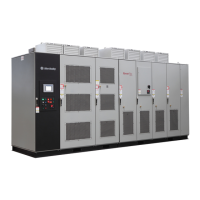Rockwell Automation Publication 6000-UM002E-EN-P - April 2018 125
Preventative Maintenance and Component Replacement Chapter 5
Connections
Inspect LV Component Terminal and Plug-in Connections
All LV control connections must be secure. Check for dirt, debris, or foreign
material, and clean with anti-static cloth if necessary.
Check relays, contactors, timers, terminal connectors, circuit breakers, ribbon
cables, control wires, etc. Check for corrosion, excessive temperature, or
contamination. Clean all components using a vacuum cleaner.
Inspect Medium Voltage Cable Connections
Verify that all MV power cable connections and grounding cables are torqued to
specification. Apply torque sealer where necessary. Check for corrosion, excessive
temperature, or contamination.
Inspect Power Cable and Control Wire Terminals
Loose connections in power circuits can cause overheating that can lead to
equipment malfunction or failure. Loose connections in control circuits can
cause control malfunctions. Loose bonding or grounding connections can
increase hazards of electrical shock and contribute to electromagnetic
interference (EMI). Check the tightness of all terminals and bus bar connections
and tighten securely any loose connections. Replace any parts or wiring damaged
by overheating, and any broken wires or bonding straps. Refer to the User Manual
for torque values required for power cable and bus hardware connections.
Inspect Transformer Secondary Windings
Check the Incoming Line Power Cable connections (L1, L2, and L3), the
Outgoing Motor Power Cable connections (U, V, W), and the Isolation
Transformer Power Cable Connections are torqued to specifications. See
Figure 14
.
Inspect LV Component Terminal and Plug-in Connections 125
Inspect Medium Voltage Cable Connections 125
Inspect Power Cable and Control Wire Terminals 125
Inspect Transformer Secondary Windings 125
Inspect Power Module Input and Output Power Connections 126

